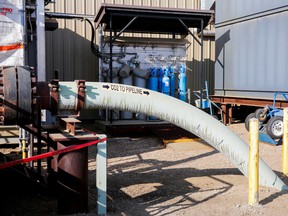
Large-scale carbon capture, the Holy Grail in Canada’s quest to meet its global climate commitments without decimating its oil and gas industry, is starting to look like a reality.
The oilpatch is eagerly awaiting details of Ottawa’s forthcoming plan to drive investment in carbon-capture technology, as even the believers acknowledge that billions of dollars still must be spent to discover a cost-effective approach to removing emissions from the air.
At the same time, Alberta’s United Conservative government announced this week that it is pushing ahead with work on six proposed carbon storage hubs in the province. The six projects feature some of the biggest names in oil and gas: Enbridge Inc.; Wolf Midstream’s Wolf Carbon Solutions; Bison Low Carbon Ventures Inc.; Enhance Energy Inc.; and joint ventures from TC Energy Corp. and Pembina Pipeline Corp., and Shell Plc, ATCO Energy Solutions Ltd. and Suncor Energy Inc.
The announcement on March 31 is the latest step in Alberta’s effort to grow a carbon capture and storage industry that the International Energy Agency (IEA) says is critical if the world is to hit net-zero emissions by 2050.
To be sure, the much ballyhooed technology has many detractors, who argue that it’s folly to base climate targets on unproven methods that could ultimately fail.
“We would have liked to see more being required of the oil and gas sector, and less reliance on unproven technologies like the carbon capture and storage,” Tom Green, senior climate policy advisor at the Suzuki Foundation, said after Prime Minister Justin Trudeau’s government released its new roadmap for reducing greenhouse gas emissions on March 29.
Trudeau appears to have sided with industry, and has indicated that his government will finally unveil a carbon capture, utilization and storage (CCUS) investment tax credit when the federal budget drops on April 7.
CCUS involves capturing emissions from industrial processes such as oil and gas production, and recycling them or transporting them via pipelines to underground sequestration sites. Bill Gates, the founder of Microsoft Corp., is among the backers of the technology. Still, the oil and gas sector, Canada’s largest emitter, says it needs Ottawa’s help to accelerate the development of carbon capture projects.

“On their own right now, they will not be profitable,” Wael Sawan, director of integrated gas, renewables and energy for Shell, said in an interview.
“So you do need targeted fiscal incentives to be able to get them off the ground and create the momentum that hopefully over time allows these to be self-financing — but that takes some time and it takes some stimulus.”
The Business Council of Canada, which includes chief executives from a number of Canada’s major oil and gas players, have said they’re looking for a “significant” tax credit in the upcoming budget, of somewhere between 50 per cent and 75 per cent for CCUS projects.
“The federal government must ensure that Canada’s CCUS policy is competitive with that of other countries, in particular the United States,” the council wrote in a February submission. “We note that in the United Kingdom, Norway and the Netherlands, significant public funding was key to the development of CCUS projects.”
The size of the credit isn’t the only factor. Industry will also be looking for clarity around the scope of projects eligible for the investment credit. Federal ministers have already signalled that projects focused on using captured carbon to enhance oil extraction won’t be eligible.
The federal government must ensure that Canada’s CCUS policy is competitive with that of other countries, in particular the United States
Business Council of Canada
But it remains an open question what types of projects will be eligible, from basic carbon sequestration to technologies that use emission to create products like concrete or low-carbon synthetic fuels.
Environmentalists have complained that providing the oil and gas industry with a tax credit for CCUS will only serve to prolong the life of the fossil fuel industry. And even energy sector proponents worry there isn’t broad public support for using tax dollars to subsidize innovation in a sector currently reaping windfall profits from surging energy prices.
Joule Bergerson, the Canada research chair in energy technology assessment at the University of Calgary, said Ottawa’s decision to implement an investment tax credit reflects the value of oil and gas to the Canadian economy and the jobs that are stake.

“Some of the pushback is that any investment that you make will perpetuate the use of fossil fuels beyond where they would have been if you hadn’t put that investment in,” Bergerson said. “I think the other risk from the public side is confidence in the ability to achieve the reductions.
“I see good reliability and good monitoring practices to ensure that that (carbon dioxide) stays under the ground, but that’s not necessarily public perception — (there’s) a need for being transparent and showing credibly that you’re managing this appropriately and that those emissions reductions will be sustained over the long term.”
Still there are some experts hoping the federal government will move quickly to find alternatives to the carbon capture investment tax credit.
One alternative is a financial instrument such as carbon contracts, or so-called carbon contracts for difference (CCfD), a derivative contract that is typically struck between the government (or an institution) and an investor agreeing on a fixed carbon price over a period of time.
Carbon contracts were floated by the Liberal government in their new Emissions Reduction Plan, and would provide some certainty to investors, which could drive private — rather than public — spending on emissions cuts.
According to Dale Beugin, vice-president at the Canadian Climate Institute, the federal government could boost investment in carbon capture or renewable projects by allowing the Canada Infrastructure Bank (CIB) to offer loans or contracts guaranteeing a fixed carbon price to project proponents and investors. The offering would allow firms to invest in projects that require a sufficiently high price on carbon to be economical, and should carbon prices fall below the contract’s strike price, the firm would be compensated by CIB.
The move would shield investors from the risk of governments changing course on carbon pricing, said Beugin, as well as ensure that governments aren’t in the position to choose winners and losers among various technologies and projects, from carbon capture to gas pipelines and infrastructure that could be repurposed for hydrogen.
“It’s totally technology agnostic,” Beugin said. “What matters is emissions reductions. Let’s crowd in private dollars as much as we can, rather than putting up this blanket public support for these kind of technologies.”
Whether it comes in the form of an investment tax incentive or a carbon contract, industry players say the most important thing is providing certainty for investment.
“These projects take many, many years to be able to develop, build and run. We’re talking decades,” Sawan said. “So what we would need is absolute certainty of policies and regulations to be able to make the multibillion dollar investments that projects like this require.”
With additional reporting from Reuters
• Email: [email protected] | Twitter: mpotkins
You can read more of the news on source
